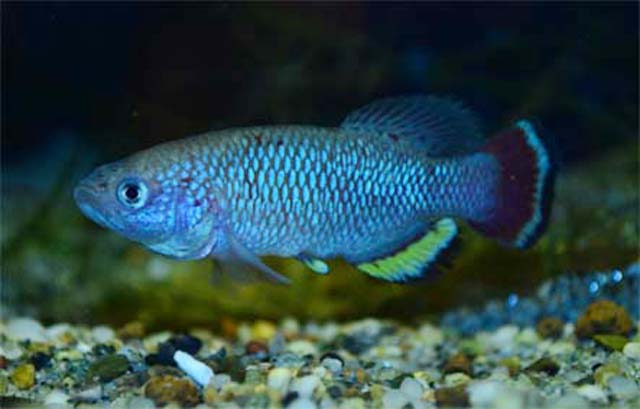|
Dorsal spines (total): 0-0; Dorsal soft rays (total): 16-17; Anal spines: 0-0; Anal soft rays: 17-18; Vertebrae: 31-32. Diagnosis: Males of Nothobranchius seegersi share with the other members of the Nothobranchius neumanni species group a combination of colouration characters, which distinguish them from all other species of the genus: caudal fin red or partially red; pectoral fin hyaline; anal fin yellow with red stripes, proximal portion light bluish grey (Ref. 87047). It is distinguihed from N. neumanni by bright light blue scales, vs. pale bluish grey; an irregular pattern formed by red scale margins on lateral body and head vs. uniform; and a single, blue male colour morph, vs. two colour morphs, blue and red; both male and female of N. seegersi have a relatively higher predorsal length compared to N. neumanni, 60.3-68.8 vs. 54.8-61.0% of standard length in males, 68.0-68.4 vs. 57.1-64.6% of standard length in females (Ref. 87047). Based on osteological characters, Nothobranchius seegersi differs from N. neumanni by having a conspicuously longer lateral process of the post-temporal, and by having short antero-dorsal process of the urohyal (Ref. 87047).
Description: A robust Nothobranchius with rounded body, maximum length recorded in males 62.0 mm standard length; dorsal profile straight to slightly concave on head, convex from nape to end of dorsal fin base; ventral profile convex, slightly concave on caudal peduncle posterior to dorsal and anal fin (Ref. 87047). Snout slightly pointed, mouth directed upwards, lower jaw longer than upper, posterior end of rictus at same level as or slightly above centre of eye; branchiostegal membrane projecting posteriorly from opercle (Ref. 87047). Dorsal and anal fin located far posterior, tips rounded with short filamentous rays; both fins with papillate contact organs on fin rays; dorsal fin tip reaching caudal fin; number of dorsal fin rays 16-17, anal fin rays 17-18; pectoral fin approximately triangular; in some specimens pectoral fins reach pelvic fins, and pelvic fins reach the anal fin origin; caudal fin rounded (Ref. 87047). Scales cycloid, body and head entirely scaled, except for ventral surface of head; scales in median lateral series 28-34 + 3-5 on caudal fin base (Ref. 87047). Cephalic squamation pattern variable; anterior neuromast series of the 'open' type; central supra-orbital series in shallow grooves, each with two or three neuromasts; posterior cephalic neuromast series curved with three or four neuromasts; one neuromast on each scale of median longitudinal series (Ref. 87047). Basihyal bone sub-triangular; six branchiostegal rays; vomerine teeth present in a large patch; lateral process of post-temporal long; single short antero-dorsal process of urohyal; number of vertebrae 31-32; premaxilla and dentary with many irregularly distributed unicuspid, slightly curved teeth of different size, a small number of larger ones on the outer row of upper and lower jaw (Ref. 87047).
Colouration: Colouration in life of males: scales on body and head bright light blue with very thin and variable red margin, creating an irregular reticulated pattern on body and head; branchiostegal membrane light blue with white margin; dorsal fin grey greenish to grey bluish with irregular rows of dark red spots proximally, which become elongate over fin rays distally; anal fin bright yellow with light blue base, separated by a dark red narrow stripe or row of dark red irregular spots, and black margin; some specimens with a median dark red narrow stripe or row of dark red irregular spots in anal fin; a sub-distal light blue narrow stripe present in anal fin of some specimens; pelvic fins yellow with red spots; pectoral fins hyaline with light blue margin; caudal fin dark red, with black margin and light blue submargin; iris golden, with faint black vertical bar through centre of eye (Ref. 87047). Colouration in life for females: scales on body and head pale greyish blue, with golden to light blue iridescence on scale centre; opercular region silvery to golden; abdomen silvery to golden; all fins hyaline; iris golden, with faint black vertical bar through centre of eye (Ref. 87047). Preserved colouration of males: scales on body light brown to whitish, almost all scales on frontal and dorsal area with distinct dark red margin, ventral scales with irregular dark red spots; dorsal fin whitish with dark red to brown spots; anal fin pale yellowish with light brown to whitish base, separated by an irregular stripe formed by dark red to brown spots, black margin; some specimens with a median dark red to brown narrow stripe or row of dark red irregular spots in anal fin; pelvic fins yellowish with dark red proximal spots and distal black spots; pectoral fins hyaline; caudal fin dark red, with black margin and distinct yellowish submargin; iris bluish (Ref. 87047). Preserved colouration in females: body light brown to whitish; opercular and ventral area yellowish; unpaired and paired fins whitish; iris bluish (Ref. 87047). |
